Whether you’re car camping or going for a big hike in the backcountry, one thing’s for sure: You’ll need to eat! When you are camping, your cooking ability and the quality of your food can still be premium with the ideal camping kitchen setup.
If you were car camping, you’ll have the luxury a bunch of big cooking equipment that can easily be hauled-in. But if you’re backpacking, it wouldn’t be convenient to carry the entire cooking setup. Instead, you need to be economical and limit it to the individual necessities like a stove, lightweight cooking gear, mugs, dishwashing, utensils, and food storage. 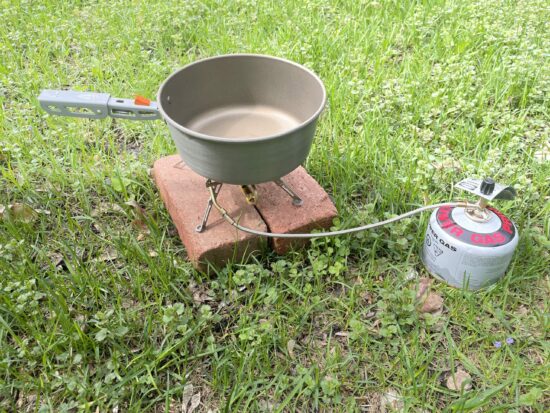
You will need lightweight gear and pots. A loaded backpacking bag should not be more than 20% of your body weight, so you should choose your items wisely. That doesn’t mean you have to compromise, though. You can get some really great quality gear nowadays!
The perfect camp kitchen setup should have three areas, and the right equipment to go along with them:
- A cooking area
- A place for prep work and cleaning
- An area to eat
To organize these three stations, here are some things you can consider.
How to Think About Your Camping Kitchen
Portability
If you are car camping, weight matters way less, and you can indulge in bigger pots, pans, and cookware. You can even bring a relatively large stove capable of cooking a pretty large meal at the one time. However, if you are backpacking, bikepacking, canoeing, or anything else where space is limited, the weight of your items is paramount, so take only what you need and make sure all your items are lightweight.
Prep and Cleanup Space
If your particular campsite allows for it, it is recommended to have a two-table kitchen setup while simple camping kitchens mostly have just one. Two surfaces are a gamechanger as far as convenience goes. Admittedly, you are probably only going to have this kind of setup if you are at a well-maintained campground, such as in a state or county park.
If you are in the backcountry, though, two tables is probably out of the question. You will be lucky to find two flat rocks (which, by the way, isn’t a bad way to work)! 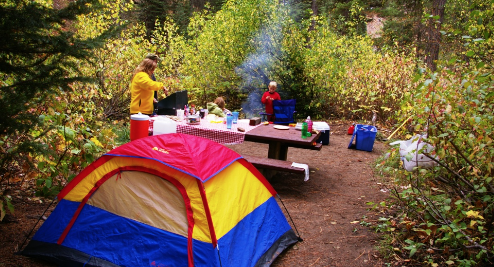
Organization
If your kitchen setup has some sort of camp tool box or closable container, or webbed lining where you can keep your pots and pans, and utensils, it will reduce clutter and keep everything in sight.
The longer you’re gone, the more food you will need to pack obviously, taking up more space. Backpackers like taking dehydrated meals as they take up less space and are lightweight, whether homemade or store-bought. A backpacker should not carry weight equal to more than 20% of their total body weight.
While most car campers have the luxury of a two-burner stove and multiple pots and pans, backpackers have to carry the barest minimum. They can also carry a cooler with plenty of food, reducing the chances that food will need to be rationed.
Camp Kitchen Essentials
Regardless of what type of camping you are doing, there are a few go-to items that you will want to be sure to have in hand.
Camping Stove
Backpackers will carry a one-burner canister stove while those who are car camping can easily carry a two-burner stove that allows for multiple dishes or group meals. Make sure to always carry an extra lighter or matches in case of emergencies.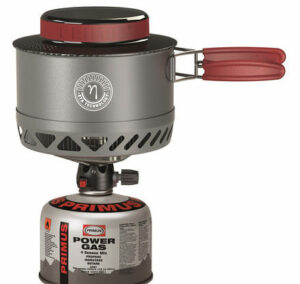
We did an entire piece on Camping Stoves, but will summarize a couple top picks for you here:
The Coleman Classic Propane Camping Stove is an excellent two-burner stove for car campers, while the MSR Pocket Rocket is a great canister stoves overall for performance, durability, and weight and great for those who are hiking-in to their campsite.
Outdoor Tableware
It is always nice to use recyclable or reusable eco-friendly tableware, so you can look out for lightweight plates and bowls made from sustainable materials. For backpackers, always look for collapsible bowls or cups that will save you some pack space. In fact, we like ones that can be tucked-in to other camp necessities, like a cooking pot. See the photo for what we mean.
Camping Utensils

A good chopping knife, cutting board, peeler, spatula, can opener, basically everything you use on a daily at home as well, you’ll need while camping. Keep it lightweight but durable, and check out all the silicone utensils.
Camping Cookware
Depending on what you intend to cook, you’ll need a pan or pot to cook in. If you can afford the space and weight, a pot would be a better choice, as you can also fry in a pot and boil water for coffee. The fact is you don’t need multiple pots and pans if you are trying to be economical on space. Buy one, and buy well.
If you’re cooking over an open flame like a campfire, car campers can think about a cast-iron skillet, as they are versatile and can last decades.
Dish-Washing Outdoors
It is easy enough to do your dishes if you have a water source, but if not, you can use a collapsible tub or portable sink. You’ll also need dish soap, sponges, and garbage bags to pack out your trash. If you are intending to do your dishes in a water source like a lake or river, be sure to use eco-friendly soap that is natural and biodegradable.
It is important to keep your camp clean, and to wash dishes immediately. Dirty dishes attract absolutely everything to your campsite — ants, birds, squirrels, mice, and even bears.
How To Organize Your Camp Kitchen
Now that you’ve got all the items necessary for your camp kitchen, you’ll have to organize your stuff. Keep your kitchen setup at least 10 ft from the campsite (to keep animals away, as they love your scraps) and also try to shelter your cooking area from the wind.

Try to keep the kitchen setup at an angle where you can see everything around you. If you have tables, set them up a short distance from each other so that the prep area can easily be reached from the cooking area. Your eating area can be located wherever you like. A spot with a view would be nice!
If you don’t have tables, try using your coolers or anything to elevate the food off the ground, or backpackers can use a tarp. Accidentally leaving food on the ground is not a good idea as it can attract animals and bugs.
Shelter your tables, gear, and food by using a pop-up shelter or tarp if you are expecting inclement weather.
Keep your trash bag near the dishwashing area away from the campsite. In some areas, trash needs to be hung from a tree, or stashed in bear-proof lockers, so check if you are entering some areas. If backpacking, never store your trash or food in your tent, even if you have a larger tent. Animals may smell the food, and not knowing you are in the tent, attempt to get at it which can be a bit terrifying.
Using Your Camp Kitchen
Lay out all the ingredients for the meal in your prep area, and set up your wash station so you can wash your cookware quickly for reuse.
Once you’ve cooked your meal in the cooking area, you’ll need to do your dishes. If you have the luxury of buckets, fill one with hot water and soap, then soak and clean the dishes. Rinse them off with cold water and pat dry before you stash them away.
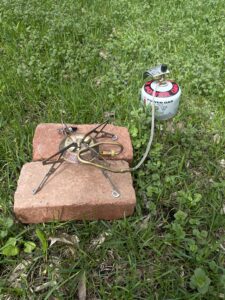
Be sure not to throw dirty dishwater into the ground near your camping area, as the scent can attract animals that you don’t want to encounter! Throw any scraps of food you have left over far, FAR away from your campsite.
Store all your food in bear-proof containers to keep away any unwanted visitors during the night.
How Much Food Should I Take Camping?
There are a few variables involved when trying to determine how much food to bring along camping.
Ideally, 2,500 to 3,000 calories a day is needed, depending on your metabolism, age, and activity levels. The more you intend to hike, the more calories you’ll need. This is roughly one and a half to two and a half pounds of food a day, so factor that into your pack weight.
A key variable, of course, is if you will be finding your own food along the way — picking berries, catching fish, etc. If you will be in a fish-rich area and are a proficient fisherperson, bringing a fillet knife might allow you to pack less food.
If you’re going on a three-day backpacking trip, you’ll need about six to seven pounds of food. Try to take foods that will help reach your desired calorie count so you will stay energetic. Always plan your meals beforehand and try to pack your comfort foods which will be much appreciated after a long day hiking!
Freeze-dried, dehydrated, ready-made meals are all perfect for when you are not in the mood to whip up a full-blown dinner. Also, if you are around a place with no water, you’ll need to plan your water rations to include what you’ll need to cook. 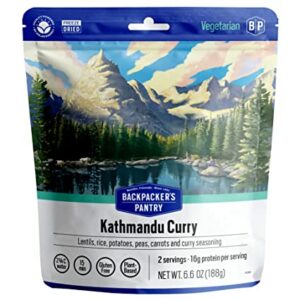
Another thing to keep in mind is the amount of fuel you will need to make all the meals in your meal plan. Some dishes take longer to cook than others so use your fuel wisely.
Test recipes at home before experimenting out in the backcountry. Sometimes when you try a new recipe, it does not turn out as expected which could lead to a waste of ingredients, time, space, and fuel.
If you have babies or toddlers accompanying you on this camping trip, make sure to have snacks and meals they enjoy at home so that you do not have to deal with pickiness or fussiness while enjoying the wilderness.
Final Thoughts
Going camping doesn’t mean you need to live on granola bars or dehydrated food. With the ideal camp kitchen setup, you can enjoy your home comforts while being nestled in the great outdoors!
Always remember that our responsibility as campers means we need to keep our food away from animals. Bears that are too used to humans often end up getting culled. Have fun and happy camping!







